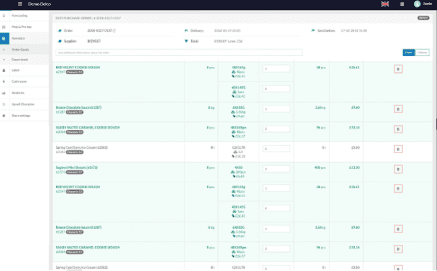The success or failure of a restaurant largely depends on the quality of its POS system. There are of course a myriad of problems and challenges that an owner has to contend with. But the fact is that most of these can be overcome, or at the very least mitigated, with a next-gen cloud-based POS platform.
Which begs the question, how did F&B operators manage before the advent of advanced next-gen technology? Short answer: they ‘got by’ with the kind of on-premises hardware that’s now obsolete.
Even today, far too many restaurant owners continue to rely on outmoded systems. There seem to be a number of reasons for this including product familiarity, a lack of resources and a fear of change.
Others are simply unaware that their restaurant management platform is holding them back, while failing to grasp the transformative potential of the latest POS systems for restaurant enterprises. And it’s this latter group for which the following article is intended.
So what constitutes a legacy system?
What is a Legacy POS System?
In the true sense of the word, a ‘legacy’ system is an outdated point of sale platform that’s primarily used to manage orders and transactions. Typically operating on a closed network and powered by physical hard drives, they rely on physical servers and are installed on site.
Even today, many systems still used by restaurants are relics of the 1990s – an era defined by POS products that combined card and cash transactions with sales data, but not a whole lot else.
More advanced on-premises POS systems have become available of course, offering far greater functionality and integration. Confusingly, these are also referred to as ‘legacy’ systems in F&B parlance.
While they do share some of the characteristics of their hopeless predecessors, such as setup and installation, this really is where the similarities end. The latest on premises platforms occupy a different technological stratosphere in terms of functionality and scope.
.jpg?width=512&height=320&name=legacy-cloud-systems(1).jpg)
Legacy POS Systems - Limitations
Regardless, both modern POS systems and genuine ‘legacy’ platforms have their limitations. Here are their most glaring shortcomings.
Basic Functionality
True legacy systems tend to be hindered by their basic functionality. Restricted to payment/ordering processing and simplistic sales reports, they typically lack the features one might expect of a more modern system, such as real-time analytics and AI-driven forecasting. Consequently, an owner’s ability to monitor the performance of their restaurant is severely hindered.
Difficult to Use
Often less intuitive than modern restaurant software solutions, many of the old-fashioned systems are a pain for staff to use, particularly those struggling front of house. Over-complicated, sluggish and unresponsive interfaces get in the way of order and payment processing causing immense frustration for servers and customers. ‘Sorry, it takes a while’ is the typical lament of a server lumbered with a sub-standard POS system.
Expensive
Installation is often expensive as are license fees and maintenance costs. Even for modern solutions, pricy long-term contracts and exorbitant upfront costs are all too common. For smaller operations this isn’t an ideal solution.
Bulky and Inflexible
Legacy POS systems often comprise bulky hardware such as a standard cash register or fixed terminal. Without the use of handheld devices, serving staff have to return to the terminal to key in orders, which in turn slows down service, increases wait times and causes bottlenecks, particularly during busy periods. Although on-premises technologies are far more streamlined, additional hardware such as servers are often required.
Limited Integration
Some of the really old legacy platforms can’t be easily integrated with other types of systems such as online restaurant ordering software, accounting programs or inventory management systems. Typically, operators are left to fill in the gaps by coming up with their own solutions. More often than not, this entails setting up spreadsheets to track data manually and struggling with multiple order streams. Errors, data inconsistency and front of house confusion usually follow.
Security Vulnerabilities
Security is another serious problem with outmoded POS systems, particularly if the manufacturer no longer offers software updates. This often happens when hardware reaches end of service. When it does, restaurant managers are often left high and dry with a system that’s more vulnerable to hacking and data breaches. The chance of system outages and lost revenue therefore increases significantly.
Limitations of Legacy POS Systems – Summary
- Basic Functionality
- Difficult to Use
- Expensive
- Bulky and Inflexible
- Limited Integration
- Security Vulnerabilities
It’s abundantly clear that genuine legacy systems leave a lot to be desired. While current on-premises systems offer powerful tools for restaurant owners, cloud restaurant POS software includes the same features but within a more scalable and flexible framework. So how does the cloud work?
What is the Cloud?
The cloud is an expansive network of servers that can be accessed via the internet. On them are installed things like applications, storage space, software and databases. Provided you’ve got login details, these resources can be accessed from anywhere.

Advantages of Cloud-Based Restaurant POS Systems
Also known as the software as a service model, (SaaS) cloud computing features numerous advantages over legacy solutions.
Accessibility
As already mentioned, cloud ePOS systems for restaurants can be accessed from any location with an internet connection. It's possible to check sales data, monitor stock levels and manage staff in real time, empowering owners to make informed decisions remotely.
Scalability
Cloud-based restaurant management platforms tend to be highly scalable, often including flexible pay-as-you-go plans that can be adjusted by operators as their requirements for additional features become more pressing. Because the actual software is centralised, it’s also very easy to add additional stores and venues.
Cost-Efficient
With no significant up-front costs required for installation or additional hardware, cloud POS restaurant systems are an attractive option for small to medium-sized restaurants. Cheaper than contract agreements which often comprise additional software licensing fees, the pay-as-you go model also tends to include ongoing maintenance, updates and technical support.
Robust Security
Cloud data is encrypted providing a robust defence against hacking and data theft. In-houses platforms are also well-secured. But in some cases, the operators must create user policies and also install anti-virus software and/or firewalls. And if the software isn’t updated, the system can become more vulnerable to security issues. With cloud POS systems, all of this is done automatically.
Quick Deployment
Cloud ePOS systems for restaurants can be set up and deployed in a matter of days. In contrast to on-premises solutions, there’s no need for an on-site server, nor is there any requirement to install applications across multiple devices.
Lower Energy Costs
Cloud-based solutions consume much less energy, unlike traditional platforms which require power-hungry servers. Because these need to run constantly they consume more energy which can have a considerable impact on energy bills.
Advantages of Cloud-Based Restaurant POS Systems
- Accessible
- Scalable
- Cost-Efficient
- Robust Security
- Quick Deployment
- Lower Energy Costs
Conclusion
Advanced cloud POS systems are setting the bar in F&B tech. In addition to the above benefits, keep in mind that best-in-class platforms include all of the features you might expect from any advanced restaurant management system.
This means AI-driven sales forecasting, automated inventory control, staff management, online ordering and menu engineering. If you’ve yet to make the transition to an advanced POS platform, a cloud-based system comes highly recommended.
Start your journey today: https://www.syrve.com/en-gb




